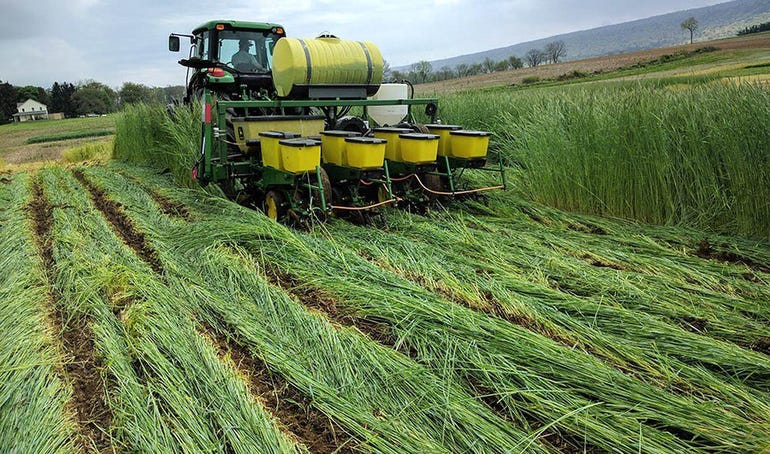July 19, 2019

Allowing cover crops to grow two weeks longer in the spring and planting corn and soybean crops into them before termination is a strategy that may help no-till farmers deal with wet springs, according to a three-year study done by Penn State researchers.
Planting green could help no-till farmers counter a range of problems they must deal with during wet springs such as soil erosion, nutrient losses, soils holding too much moisture, delays in planting and crop damage from slugs.
"With climate change bringing the Northeast more extreme precipitation events and an increase in total precipitation, no-till farmers especially need a way of dealing with wet springs," says Heather Karsten, associate professor of crop production ecology. "We wanted to see if farmers could get more out of their cover crops by letting them grow longer in the spring."
In a planting green system, cover crops continue to grow and draw moisture from the soil, creating drier conditions in wet springs for planting corn and soybeans. After the cash crops are planted, the cover crops are typically terminated with a herbicide. The decomposing cover crop residues then preserve soil moisture for the corn and soybean crops through the growing season.
The three-year study took place at five sites: on three cooperating Pennsylvania farms that plant no-till in Centre, Clinton and Lancaster counties; at Penn State's Russell E. Larson Agricultural Research Center in Rock Springs; and at the Southeast Agricultural Research and Extension Center in Landisville.
At each location, researchers compared the results of planting green to the traditional practice of terminating cover crops 10 days to two weeks before planting corn and soybeans. Cover crops in the study were primarily rye and triticale, as well as a mixture of triticale, Austrian winter pea, hairy vetch and radish in one location.
Researchers used TA575-20 corn, a 107-day variety, in Landisville and Lancaster; and TA477-18, a 97-day variety, at locations in Rock Springs and in Clinton County.
The soybean was TS2849R2S, a 2.8 RM at all sites except for Rock Springs in 2016, where they used an equivalent 2.6-RM variety.
In Rock Springs and Landisville, cover crops were roller-crimped and cash crops were planted in the same pass using the Dawn ZRX residue management system, mini rollers that attach to each row unit.
At a Centre County site, cover crops were never rolled and only soybeans planted.
In Clinton County, the cover crops were rolled, and corn planted in 2016 and 2017; in 2015, the cover crops were not rolled before the soybeans.
In Lancaster County, cover crops were not rolled in 2015 but they were rolled before cash crop plantings in 2016 and 2017 using a Buffalo rolling stalk chopper.
Better for soybeans
The findings, recently published online in Agronomy Journal, were mixed, according to study leader Heidi Reed, a Ph.D. student in agronomy who is an educator with Penn State Extension.
She noted that planting green appeared to benefit soybeans more than corn.
Planting green increased cover crop biomass by 94% in corn and by 94% to 181% in soybeans. However, the cover crop residues also cooled soils from 1.3 to 4.3 degrees F at planting.
At several of the sites, planting populations were reduced in the planting green plots, possibly due to the cooler temperatures slowing crop emergence and nutrient cycling, or from cover crop residue interference with the planter. In a few cases in corn, crop damage by slugs was also increased when corn was planted green.
 PLANTING GREEN: Researchers plant corn into growing cover crop during a trial at the Rock Springs, Pa., research farm just outside State College.
PLANTING GREEN: Researchers plant corn into growing cover crop during a trial at the Rock Springs, Pa., research farm just outside State College.

No-till farmers struggle with slugs damaging corn and soybean seeds because no-till doesn't disturb the soil and kill slugs or bury their eggs the way tillage does.
"No-till with cover crop residues also provides habitat for some crop pests and keeps the soil moist, so no-till cover crop systems tend to be great slug habitat," Karsten says. "We had hoped that letting cover crops grow longer in the spring would supply alternative forage for the slugs as well as habitat for slug predators such as beetles, and these factors would reduce slug damage of the main crop seedlings. But we did not see a consistent reduction in slug damage on main crops as we expected."
Mixed yields
When researchers compared crop yield stability between the two cover crop termination times, corn yield was less stable and reduced by planting green in high-yielding environments. Soybean yields, though, were not affected by planting green.
"We concluded that corn was more vulnerable to yield losses from conditions created by planting green than soybeans," Reed says. "Since soybean yield was stable across study locations and not affected by cover crop termination date, we suggest that growers who want to extend cover crop benefits and avoid the risk of crop-yield reduction from planting green should consider trying it first with soybean."
 SLUG STRUGGLES: One suspected benefit of planting green is reducing slug damage in cash crops due to their being an alternative for the critters, but the study no consistent evidence of this.
SLUG STRUGGLES: One suspected benefit of planting green is reducing slug damage in cash crops due to their being an alternative for the critters, but the study no consistent evidence of this.

Northeast Sustainable Agriculture Research and Education and the USDA’s National Institute of Food and Agriculture supported this research.
Source: Penn State University, which is solely responsible for the information provided and is wholly owned by the source. Informa Business Media and all its subsidiaries are not responsible for any of the content contained in this information asset.
You May Also Like




